Non-alcoholic fatty liver disease (NAFLD) is often referred to simply as fatty liver. It is one of the most common liver conditions affecting people worldwide1. This condition involves the buildup of excess fat in the liver that is not caused by the consumption of alcohol2.
In India, adult NAFLD rates have been reported as high as 38.6% in adults and 35.4% in children, and the prevalence is known to increase with age and lifestyle related health issues3. Fatty liver can range in severity from simple fat accumulation (non-alcoholic fatty liver or NAFL) to a more serious form called non-alcoholic steatohepatitis (NASH), which can lead to liver fibrosis, cirrhosis, or even liver cancer if left unaddressed1.
The good news is that regular physical activity is one of the most effective ways to manage fatty liver1,3. In this article, we will explore the causes and symptoms of fatty liver and highlight the most effective exercises you can incorporate into your routine to support liver health and manage this condition. Keep in mind that choosing the best exercise for fatty liver means focusing on activities that improve cardiovascular health as well as promote weight loss.
Fatty liver develops when there is an abnormal buildup of fat in liver cells, more than 5% of the liver’s weight2,5. This fat accumulation occurs due to various conditions:
Beyond this, several other conditions and factors can contribute to NAFLD:
NAFLD or NASH is now often referred to as Metabolic Dysfunction-associated Steatotic Liver Disease (MASLD), and the most common cause for this is obesity or being overweight22,23.
Dr. Nayana Shetty, MBBS, MD
Most people with fatty liver disease (especially in the early stages) may not experience any symptoms1. However, as the condition progresses, some people might start to notice signs that something isn’t quite right.
Below, we have mentioned some common symptoms of a fatty liver:
It’s important to note that these symptoms are not exclusive to fatty liver disease and may be associated with other health conditions. However, as the condition progresses to NASH and cirrhosis, signs like abdominal/leg swelling, itchy skin, and spider-like veins may appear9. That’s why regular health check-ups are crucial, especially if you have risk factors like obesity, diabetes, or high cholesterol.
If you’re concerned about your liver health, you can get a simple test, such as Liver Function Test (LFT), to check how well your liver is working. This blood test measures levels of liver enzymes and can help detect early signs of liver problems.
One of the most effective ways to improve fatty liver disease is through regular exercise. Are you wondering what the best exercise for fatty liver is? The answer lies in a combination of aerobic activities like walking and strength training for lasting benefits. Studies have shown that both aerobic (cardio) and resistance (strength) training have been proven to reduce fat in the liver10,11.
Here are some simple and effective exercises for fatty liver that you can include in your daily routine:
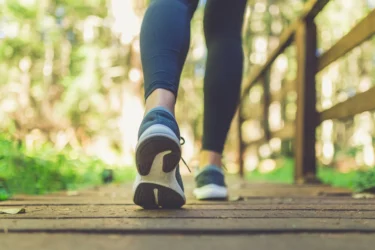
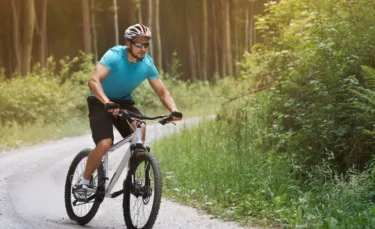


Note: While exercise and yoga offer certain benefits for fatty liver, it is important to perform activities within your comfort level and under the guidance of fitness and yoga professionals. Additionally, if you have any underlying health conditions, it is important to take medical clearance with the medical practitioner before pursuing any exercise regime.
There is a growing trend pf NAFLD in children which is closely linked to rising childhood obesity24.
Dr. Nayana Shetty, MBBS, MD
Yoga is a powerful tool that not only reduces stress but also helps stimulate internal organs like the liver, enhancing detoxification and improving its function16. Hence, it can be particularly beneficial for individuals with fatty liver disease. Here are some asanas that you can try out:
Steps17:
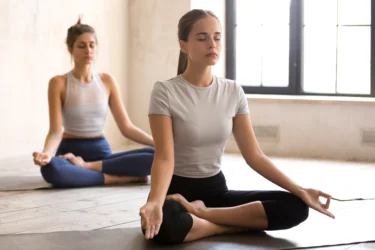

Steps19:
Duration and Frequency18:

Steps19:
Duration and Frequency:
Benefits19:

Steps17:
Duration and Frequency:
Benefits17:

Steps17:
Duration and Frequency:
Benefits17:
Note: Always practice yoga for fatty liver with awareness and within your comfort level. If you have any underlying health conditions, recent surgeries, or are pregnant, consult your doctor before starting20. It’s best to learn and perform yoga under the guidance of a certified yoga instructor to ensure proper technique and safety. Ideally, practice yoga in the early morning or at a time when your stomach is empty for better results and comfort17.
No particular exercise can specifically target the fat in liver. Generally incorporating any type of physical activity is one of the many lifestyle measures that can be taken to inch towards a healthy liver. When concerning symptoms do show up, consulting your doctor is important.
Dr. Nayana Shetty, MBBS, MD
Also Read: Signs You May Have Liver Stress
In addition to medical guidance and structured treatment, individuals with fatty liver disease can adopt several practical lifestyle measures to support liver health:
Also Read: Exercises for Hernia. Dos and Don’ts
Fatty liver disease often develops silently, but timely medical consultation is advised when you notice the above-mentioned symptoms to rule out this condition. If the disease progresses, it becomes crucial to seek immediate medical attention. You must visit the doctor if you experience any of the following, as these may indicate that the liver disease has advanced:
As NAFLD progresses, it may develop into non-alcoholic steatohepatitis (NASH), a more severe form that includes inflammation and liver cell damage. If left unmanaged, NASH can progress to fibrosis, cirrhosis, or liver cancer2. Therefore, regular medical check-ups and early lifestyle interventions such as exercise for fatty liver are key to managing fatty liver disease and avoiding long-term complications.
Also Read: Safe Stretching Exercises You Can Try If Suffering From Phimosis
Exercise and yoga play a vital role in managing fatty liver disease by promoting weight loss, enhancing insulin sensitivity, reducing liver fat, and improving overall metabolic health. While there is no single best exercise for fatty liver approved solely for NAFLD, consistent physical activity, combined with mindful practices like yoga, can significantly halt the progression of the disease.
By adopting a healthier lifestyle that includes regular exercise, a balanced diet, stress reduction, and mindful habits such as yoga, individuals can not only manage fatty liver more effectively but also improve their overall well-being. Regular consultation with a doctor with early intervention and sustained lifestyle changes is key to avoiding complications and leading a healthier, more energetic life.
Also Read: 6 Best Yoga Poses & Exercises To Deal With Piles
Exercise is an important aspect of managing fatty liver disease that can significantly help reduce liver fat. However, it works best when combined with a healthy diet and lifestyle changes20.
No, moderate-intensity exercise is sufficient for most people to improve liver health11. Vigorous or high-intensity exercise can help, but it is not mandatory and should be done only if comfortable and safe.
Always start at your own pace and avoid pushing yourself too hard. If you experience pain, dizziness, or difficulty breathing during exercise, you should stop immediately and consult a doctor. Individuals with existing health conditions should always seek medical advice before starting any new exercise or yoga regimen.
22. Li B, Zhang C, Zhan YT. Nonalcoholic Fatty Liver Disease Cirrhosis: A Review of Its Epidemiology, Risk Factors, Clinical Presentation, Diagnosis, Management, and Prognosis. Can J Gastroenterol Hepatol. 2018 Jul 2;2018:2784537. doi: 10.1155/2018/2784537. PMID: 30065915; PMCID: PMC6051295.Available from: https://pmc.ncbi.nlm.nih.gov/articles/PMC6051295/
23. Sharma B, John S. Nonalcoholic Steatohepatitis (NASH) [Updated 2023 Apr 7]. In: StatPearls [Internet]. Treasure Island (FL): StatPearls Publishing; 2025 Jan-. Available from: https://www.ncbi.nlm.nih.gov/books/NBK470243/
24. Zhang X, Wu M, Liu Z, Yuan H, Wu X, Shi T, Chen X, Zhang T. Increasing prevalence of NAFLD/NASH among children, adolescents and young adults from 1990 to 2017: a population-based observational study. BMJ Open. 2021 May 4;11(5):e042843. doi: 10.1136/bmjopen-2020-042843. PMID: 33947727; PMCID: PMC8098935. Available from: https://pmc.ncbi.nlm.nih.gov/articles/PMC8098935/#:~:text=Prevalence%20of%20NAFLD/NASH%20and%20its%20variations%20among%20CADs%20and,SDI%20regions%20(table%201).
Disclaimer: The information provided here is for educational/awareness purposes only and is not intended to be a substitute for medical treatment by a healthcare professional and should not be relied upon to diagnose or treat any medical condition. The reader should consult a registered medical practitioner to determine the appropriateness of the information and before consuming any medication. PharmEasy does not provide any guarantee or warranty (express or implied) regarding the accuracy, adequacy, completeness, legality, reliability or usefulness of the information; and disclaims any liability arising thereof.
Psyllium husk or isabgol husk is a natural polymer1,2. It’s made from the outer layers of the seeds of Plantago ovata Forsk (P. ispaghula Roxb.). Isabgol is rich in fibre and mucilage. Mucilage is a colourless gelling agent capable of expanding in volume as it absorbs water up to 40 times its weight1. Dietary fibre obtained from psyllium husk may be used in processed foods, as an ingredient of foods, and in health supplements2.
Originating from Western Asia, isabgol is an annual herb. Indian Muslims introduced its medicinal properties from seeds collected firstly from some wild species3. India is presently the major producer and exporter of isabgul husk in the world4.
The nutrients present in psyllium husk are as follows2:
Isabgol has several advantages for maintaining a healthy life. It is safe and effective for some conditions if taken in a recommended dose.
Isabgol may restrict butyric acid’s antineoplastic activity. Thus, it’s considered beneficial in preventing colorectal cancer5.
Isabgol fibres (soluble and insoluble) have significance in reducing total low-density lipoprotein and serum cholesterol. Thus, it helps reduce the risk of heart diseases5.
Supplementing isabgol in the diet is helpful in managing haemorrhoids. Since isabgol helps in dealing with both constipation and loose stools, it would also help in managing haemorrhoids. In a comparative study8, people treated with a placebo of B vitamins had no major difference, and those consuming isabgol had a reduction of bleeding.
Studies9 on a population with type II diabetes have shown that isabgol husk effectively improved glycaemic and lipid control after meals.
Including psyllium in your diet may help regulate your blood sugar levels and improve your overall metabolic health. Psyllium has the ability to enrich certain foods like breakfast cereals, pasta, bread, and some snacks, which can be beneficial for individuals with lipid and carbohydrate metabolism disorders, especially obese adolescents and children.
Dr. Siddharth Gupta, B.A.M.S, M.D (Ayu)
Seek advice from your Ayurvedic physician on dosage as per your health condition4.
Also Read: Instant Home Remedies for Digestive Problems
Side effects observed with isabgol consumption are as follows:
Also Read: Lady Finger (Bhindi): Uses, Benefits, Side Effects and More!
Keep the following points in mind:
Incorporating psyllium into your diet may be beneficial as psyllium husk might be a natural prebiotic. Psyllium husk contains about 15% fermentable fibre, which can support the growth of beneficial bacteria in your gut.
Dr. Rajeev Singh, BAMS
Also Read: Triphala: Uses, Benefits, Side Effects & More!
Yes, many researchers have investigated the potential health benefits of isabgol husk, particularly in weight loss and controlling obesity in children and adults4.
Yes, some studies6 have shown that taking isabgol husk for weight loss may lead to menstrual disturbances like prolongation of the cycle by 7-10 days and irregular menstrual cycles.
No, you should avoid consuming isabgol while fasting due to potential reductions in blood sugar levels caused by isabgol2,5.
Yes, isabgol should be taken with a sufficient amount of water or any other fluid like milk5.
Yes, isabgol may help in relieving inflammation, as it has anti-inflammatory properties7.
No, there are no reported benefits of isabgol husk in skin treatment.
Disclaimer: The information provided here is for educational/awareness purposes only and is not intended to be a substitute for medical treatment by a healthcare professional and should not be relied upon to diagnose or treat any medical condition. The reader should consult a registered medical practitioner to determine the appropriateness of the information and before consuming any medication. PharmEasy does not provide any guarantee or warranty (express or implied) regarding the accuracy, adequacy, completeness, legality, reliability or usefulness of the information; and disclaims any liability arising thereof.
Jambolan, Indian blackberry, jamun, black plum, java plum, Malabar plum, Portuguese plum, purple plum, damson plum, and Jamaica are common names for Jamun fruit in english. The tree is found throughout the Indian subcontinent and many other South Asian countries, including Burma, Bangladesh, Nepal, Pakistan, Indonesia, and Sri Lanka[6].
It is a powerhouse of nutrients and medicinal properties. This deep purple fruit is widely cherished for its unique sweet-tart flavor and numerous health benefits. Rich in vitamins, minerals, and antioxidants, Jamun has been used in Ayurvedic and traditional medicine for centuries to help manage diabetes, improve digestion, and boost immunity.
Did you know?
Anthocyanins, ellagic acid, glucoside, isoquercetin, kaemferol, and myrecetin are among the compounds found in jambolan. The alkaloid jambosine and the glycoside antimellin or jambolin are said to be present in the seeds[1].
The nutritional content found per 100 g of edible jamun fruit is[2]:
Various parts of the Jamun plant are known for different medicinal benefits, as listed below[1].
I find it interesting that Jamun wood is known for its strength and resistance to water and termites. This means that it can withstand moisture and insect damage, making it a durable and long-lasting material.
Dr. Siddharth Gupta, B.A.M.S, M.D (Ayu)


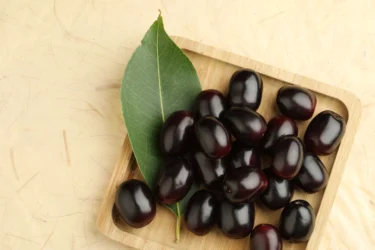
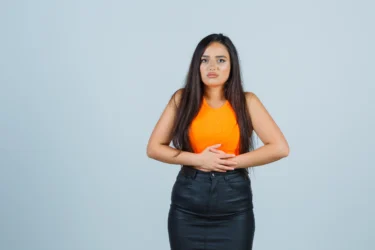
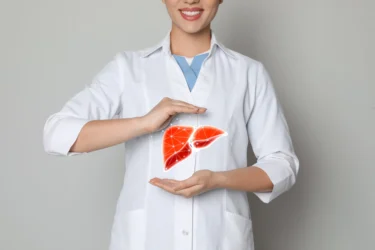

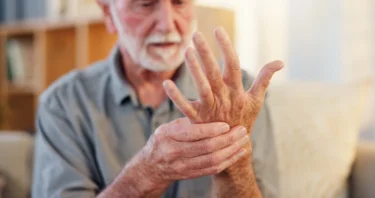




In my experience, I have observed that consuming Jamun fruit extract may have positive effects against obesity. It appears to regulate gut microbial populations, leading to improvements in weight management, insulin sensitivity
Dr. Rajeev Singh, BAMS
Also Read: Papaya Leaves and Seeds to Treat Fever and Other Ailments
Consult an ayurveda doctor and understand the correct dose and form of jamun (Java plum fruit) that can help improve your health.
The following parts of jamun can be used for medicinal benefits.
Also Read: Low Glycemic Index Fruits for Diabetic People
As reported in the literature, flatulence, delayed digestion, laryngitis, inflammation in the lungs, and emphysema are all possible side effects of Jamun fruit. This may vary from person to person depending on the dosage and duration of the product consumed.
Jamun (Java plum) has been used for its medicinal properties in Ayurveda. Different parts of this tree are used for different ailments. It is best to consult an ayurveda doctor and understand the form, dosage and duration of jamun extracts that can be helpful based on your health condition. People with ongoing medicines and conditions like diabetes, liver disease, etc, should speak to their doctor before trying any ayurvedic or herbal remedy.
Also Read: Lychee: Uses, Benefits, Side Effects and More By Dr. Rajeev Singh
Anthocyanins, ellagic acid, glucoside, isoquercetin, kaemferol, and myrecetin are among the compounds found in jambolana[1].
Yes, it is good for the liver. E. jambolana showed liver protective activity in rats by lowering the liver serum enzyme levels that were high and improving the production of protein and albumin by repairing liver cells[3].
Jamun is known as Black Plum, Java Plum, or Indian Blackberry in English. Other names like Jambolan, Malabar plum, Portuguese plum, purple plum, etc. are common names of jamun[1].
Yes, jamun fruit is good for diabetes. The antidiabetic activity of E. jambolana seed powder was observed as increased body weight and improvement in peak blood glucose levels in rat study[3].
Jamun can be good for dogs in small quantities. It is rich in antioxidants and vitamins, but excessive consumption can cause digestive issues, so it’s best to consult with a veterinarian before adding it to your dog’s diet.
Jamun fruit has a unique flavor that is typically described as sweet and tangy with a slightly astringent aftertaste. Its taste can vary depending on the ripeness, but it generally combines elements of sweetness and tartness, making it distinctive among fruits.
No, jamun fruit does not cause cold. Cold viruses are typically responsible for causing colds, not fruits. Jamun is rich in vitamin C and antioxidants, which can support immune health and may help prevent colds, but it does not directly cause them.
There is no direct evidence suggesting that jamun causes acne. However, individual reactions to foods vary, and consuming excessive amounts of sugary fruits like jamun could potentially contribute to acne in some people prone to breakouts. As part of a balanced diet, moderate consumption of jamun is unlikely to cause acne for most individuals.
Jamun can cause gas or bloating in some individuals, particularly if consumed in large quantities or if they have a sensitive digestive system. Its high fiber content may stimulate bowel movements and gas production. Adjusting portion sizes and observing personal tolerance can help mitigate these effects.
Blueberry and jamun (Indian blackberry) are not the same fruit. They differ in appearance, taste, and nutritional content. Blueberries are smaller with a sweet flavor, while jamun is larger, purple-black, and has a unique tangy-sweet taste. Both are rich in antioxidants but come from different plant species.
Yes, consuming jamun can sometimes cause black stool due to its natural pigments and high iron content. This discoloration is typically harmless and temporary but consulting a doctor if concerned is advisable, especially if accompanied by other symptoms.
Jamun is generally considered beneficial for kidney health due to its diuretic properties, which may help promote urine production and support kidney function. However, individuals with kidney disease should consult a healthcare provider to determine if jamun is suitable for their specific condition and dietary needs.
Yes, jamun can be beneficial for acidity. It has a natural alkaline effect that can help neutralize acid in the stomach, providing relief from acidity and heartburn. However, individual responses to foods can vary, so it’s advisable to consume them in moderation and observe personal tolerance levels.
Yes, jamun is high in potassium. This mineral helps regulate blood pressure, supports heart health, and balances electrolytes in the body.
Yes, jamun is good for the stomach. It aids digestion, relieves constipation, and helps treat gastric disorders due to its high fiber content and natural astringent properties.
Disclaimer: The information provided here is for educational/awareness purposes only and is not intended to be a substitute for medical treatment by a healthcare professional and should not be relied upon to diagnose or treat any medical condition. The reader should consult a registered medical practitioner to determine the appropriateness of the information and before consuming any medication. PharmEasy does not provide any guarantee or warranty (express or implied) regarding the accuracy, adequacy, completeness, legality, reliability or usefulness of the information; and disclaims any liability arising thereof.
Mustard oil is versatile and used in many parts of the world. It is popularly known as Sarson ka Tel in India and is a key ingredient found in every kitchen. Mustard oil has a strong flavour and enhances the taste of several dishes. Not only that, but it also has numerous health benefits.
But with the fear of cholesterol and an upswing in heart diseases, many people have now become cautious of the kind and quality of oil that they consume on a daily basis. This has led to a widespread increase in the sale of healthy oils such as Olive oil, Sunflower oil, Rice Bran oil and Grapeseed oil.
It is also worth noting that mustard is good for diabetes, owing to its anti-inflammatory properties. So, it is considered one of the ideal oils that can be used in recipes for diabetes.
Mustard oil has about 60% monounsaturated fatty acids(MUFA)(42% erucic acid and 12% oleic acid); it has about 21% polyunsaturated fats(PUFA) (6% omega-3 alpha-linolenic acid(ALA) and 15% omega-6 linoleic acid(LA)) and it has about 12% saturated fats1.
This optimum ratio of omega-3 and omega-6 fatty acids and low content of saturated fats makes mustard oil more beneficial and preferred over several other oils available in the market.
Mustard oil is reddish-brown or amber in colour and is known for its strong smell and pungent, sharp flavour. The pungency of mustard oil is due to the presence of allyl isothiocyanate. This fatty vegetable oil is obtained by pressing mustard seeds.
For now, let’s understand Mustard Oil and its benefits in detail.
Mustard oil is a healthy edible oil it is low in Saturated fatty acids (SFA), high in MUFA and PUFA, especially alpha-linolenic acid and has a good LA: ALA ratio (6:5).
In Myocardial infarction (MI) patients using mustard oil, there was a reduction in arrhythmias, heart failure and angina2. Thus, mustard oil is considered a healthy choice for patients with cardiovascular disorders.
N6 (linolenic acid) and N3 (alpha-linolenic acid) are essential fatty acids that have been proven to be beneficial for the body. N6 PUFA lowers LDL cholesterol but can also decrease HDL3, whereas N3 PUFA may lower triglycerides, blood pressure, inflammation, improve vascular function and sudden death.
Since ancient times, mustard oil has been used to soothe colds, coughs and other respiratory illnesses and allergies.
Inhaling steam containing mustard oil has been shown to clear respiratory congestion4. Also, a concoction made by heating mustard oil, a few cloves of garlic and 1 teaspoon of ajwain, when massaged on our feet and chest, provides relief from cold and cough. Mustard oil may also show positive effects in patients suffering from sinusitis4.
Glucosinolate, available in mustard oil, which accounts for antibiotic, fungicidal and cancer prevention qualities, serves as a therapeutic for human health. It thus protects us from colorectal and gastrointestinal cancers5.
Allyl isothiocyanate serves as an antifungal agent, which protects food from fungal growth and reduces infection5.
Mustard oil is a major source of all fats required by our body to perform diverse biological functions as components of plasma, cell lipids and cell membranes. Mustard oil reduces cholesterol and improves the membrane structure of red blood cells (RBC)6.
Mustard oil is a natural stimulant that is known to stimulate our sweat glands, thereby improving blood circulation throughout the body. By increasing blood circulation in the entire body, it also relieves and rejuvenates stressed and overworked muscles. It also helps to lower body temperature and remove toxins from the body7.
A regular massage with mustard oil helps in relieving aching joints and muscles. Arthritis patients also experience relief and comfort after a massage with mustard oil, thanks to the presence of Omega-3 fatty acids that help to ease stiffness and pain caused due to arthritis8, 9.
The composition of mustard oil is based on our body’s requirements. This oil has <7% saturated fat, high amounts of monounsaturated fatty acids, ranging from 3.6-32.2%. It also contains a considerable amount of linoleic (18:2) and linolenic acids (18:3)6.
The optimum range of omega-3 and omega-6 fatty acids and vitamin E provides the required nutritional value and boosts our immune system6.
The amount of vitamin E in the alpha-tocopherol present in mustard oil has beneficial effects in controlling diabetic hazards5.
Trans fat is the major cause of insulin failure and high oxidation of fat. The absence of trans fat in mustard oil thus helps maintain insulin levels, which in turn regulates our blood sugar levels.
Mustard oil is extremely useful and can be consumed by people who are underweight. It makes you want to eat more by pumping your stomach and facilitates the secretion of gastric juices and bile, which is known to create the feeling of hunger10.
Research suggests that mustard oil may also help in slowing down the growth and spread of certain types of cancer cells in your body11.
Massage in infancy with mustard oil helps improve growth and post-massage sleep. Massage with mustard oil helps improve the weight, length and midarm and midleg circumferences as compared to infants without massage12.
Mustard oil helps strengthen your gums and makes it easier to remove the plaque. Plaque is generally formed due to bacteria that are surrounded by fatty membranes. Swishing mustard oil in our mouth can help loosen the fat-soluble bacteria and further prevent gum bleeding.
Mustard oil contains alpha fatty acids that keep our hair hydrated and lively and help it to grow faster10. Mustard oil is also a rich source of antioxidants, minerals like iron, calcium and magnesium and vitamins like A, D, E and K, all of which are important for hair growth.
The antifungal properties of mustard oil also prevent the development of fungus and dandruff on our scalp7.
Mustard oil is rich in vitamin B complex, vitamin A, vitamin E, calcium, protein and omega 3 fatty acids. This helps reduce fine lines and wrinkles13. It also helps to remove tan from the skin. Mustard oil also works wonders if you have chapped lips.
The anti-bacterial and anti-fungal properties of this oil prevent the development of acne and keep our skin clean and glowing4.
In my experience, I have found that mustard oil has been traditionally used as a rubefacient and irritant due to its topical irritant effects. When applied to the skin, mustard oil can cause a warming sensation and increased blood flow to the area, which may help alleviate pain.
Dr. Siddharth Gupta, B.A.M.S, M.D. (Ayu)
Read More: 7 Home Remedies for Glowing Skin.
The pungent and strong smell of mustard oil makes it a natural mosquito repellent. Rub a few drops of mustard oil on the skin and drive mosquitoes away.
Also Read: 21 Healthy Benefits Of Almonds: Facts And FAQs
Also Read: Is Palm Oil Bad for You?
Mustard and sunflower oil are the two most used oils in India. The consumerist-oriented market has spoiled people with choices, with avocado, groundnut, and olive oil running the race as well. With being the two most popular cooking oils, the debate on which ranks higher in benefits has been going on for a long time.
Mustard oil, derived from mustard seeds, is dark yellow and has a pungent odour. Mustard oil is widely used as cooking oil in major Indian households, as it has the benefit of not accumulating in the blood vessels. It contains healthy fats like omega-3 and 6, along with helping reduce cholesterol levels. Mustard oil for hair oiling has been used for centuries. Consumption of mustard oil is recommended to be done in moderate amounts, as it contains considerable amounts of erucic acids. Too much mustard oil can cause anaemia or diarrhoea.
On the other hand, refined sunflower oil is a chemically-treated oil that has been made to look clearer by removing impurities, contaminants and odour. Not many benefits of refined oil besides the fact that it is made to cater to the customers’ needs, like refined oil for heart patients. The harmful effects of refined oil are based on the fact that it is chemically treated. The process of refining involves nickel, in addition to sodium hydroxide and preservatives, which are harmful to the digestive system in the long run.
Also Read: Eat These 10 Foods To Fight Fatigue!
Disclaimer: The information provided here is for educational/awareness purposes only and is not intended to be a substitute for medical treatment by a healthcare professional and should not be relied upon to diagnose or treat any medical condition. The reader should consult a registered medical practitioner to determine the appropriateness of the information and before consuming any medication. PharmEasy does not provide any guarantee or warranty (express or implied) regarding the accuracy, adequacy, completeness, legality, reliability or usefulness of the information; and disclaims any liability arising thereof.
Oedema is a common condition that affects many people all over the world. In simple terms, oedema is defined as swelling that occurs due to fluid accumulation in the tissues, and is particularly seen in the hands, feet, ankles, arms, and legs. There are many factors that can lead to oedema, such as heart or kidney diseases, less protein in blood, lung infection and poor blood flow, which requires medical attention when severe1. Additionally, it is necessary to know that even the foods you eat can play a crucial role in avoiding and managing the oedema.
In this article, we will discuss the nature of oedema, types of food that can worsen oedema, explore healthier alternatives, and various lifestyle changes that may help in managing and avoiding this condition. Furthermore, we will also discuss oedema that occurs during pregnancy and answer some frequently asked questions.
Did you know?
Oedema occurs when fluid leaks from small blood vessels into nearby tissues, leading to the following symptoms1.
The types of oedema are based on the area of the oedema and its root cause. Some well-known types of oedema include:
A healthcare provider will examine the affected area, inquire about medical history, any trauma, onset, position change, triggering factors, and may request additional tests to determine the root cause of oedema. Some possible tests include blood tests, ultrasound exams, vein studies, or other necessary diagnostic studies8. Mild oedema usually resolves on its own, but more severe cases may require medication to manage the underlying cause1.
Avoid consuming pickled vegetables if you have edema. These foods are high in sodium due to the pickling process, which involves soaking them in a solution containing salt and vinegar. High sodium intake can worsen fluid retention and exacerbate edema symptoms. Opt for fresh vegetables instead to help manage edema more effectively
Dr. Siddharth Gupta, B.A.M.S, M.D (Ayu)
Foods that may worsen oedema include:

High salt intake increases the sodium content in your body, which retains more fluid and worsens oedema3. High sodium is found in unhealthy foods like fast foods, sauces, canned soups, deli meats, and bakery productions.

Processed foods are not only high in fat, they may also cause edema. Examples are chips, crackers, cookies, candy, and ice cream.

Fat-rich foods such as baked goods, meats, and cheese take longer to digest, which may lead to bloating and oedema.

Foods and drinks that cause inflammation may worsen oedema. Common examples include refined sugars, artificial sweeteners, trans fats, and alcohol2.
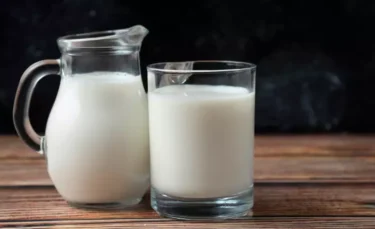
Lactose, found in dairy products like milk and ice cream, can lead to an upset stomach and bloating in people who are lactose intolerant. Probiotic-rich yogurt or lactose-free alternatives might help in such individuals.
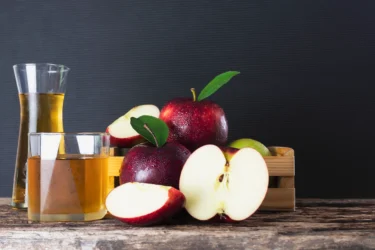
Some foods can trigger stomach upset and add to oedema. These include:
High-processed refined carbohydrates such as pasta may also increase water retention in the body. It is best to avoid these if you have edema and opt for healthier options.
Dr. Rajeev Singh, BAMS
Knowing what to eat and drink plays an important part in dealing with oedema. Making good dietary choices may help keep your health in check.
Pick nutrient-rich, low-inflammation, and low-sodium foods to manage oedema.
Drinking adequate amount of water each day to avoid fluid retention. You may add lemon, mint, or berries to your water for a refreshing twist. Overdrinking water can add to oedema.
Regular breaks throughout the day help avoid long periods of sitting or standing and raising your legs above your heart level helps drain the oedema.
Avoid tight clothes that can limit blood flow and add to oedema symptoms.
Use waist-high compression stockings to avoid fluid build-up in your limbs by promoting better blood flow with gentle pressure.
Regular workouts and a healthy weight boost circulation, and overall health, and help reduce oedema symptoms.
Also Read: What Causes Sulphur Burps and How To Stop Them
Pregnancy brings many changes to your body. One of them could be swelling or oedema. It’s crucial to know what triggers it and how to manage it10.
Swelling in pregnancy usually starts in the second term and may get worse by the third term.
Here are some self-care tips that may help you manage oedema.
Sudden severe swelling or swelling with symptoms like headaches, dizziness, or vision problems need quick medical attention. These symptoms may indicate a serious pregnancy complication like preeclampsia.
Always remember, whether you are pregnant or not, if home remedies do not help, the swelling keeps getting worse, or it is accompanied by other concerning symptoms, you should seek medical care.
Also Read: Why Should You Drink Water in the Morning Before Brushing?
In summary, understanding and managing the impact of oedema on your body is crucial for overall health and well-being. Be aware of the types and causes of oedema and identify the foods and drinks that can aggravate the condition. Focus on healthier alternatives and adopt beneficial lifestyle changes to keep oedema at bay. Moreover, it’s essential to recognise the triggers and warning signs of oedema and know when to seek medical guidance. Stay proactive and make informed decisions to lead a healthy, active life.
Processed, high-salt, high-fat, high-sugar foods and certain dairy products can make oedema worse.
Regular exercise, weight management, and balanced diet can help reduce the oedema9.
Yes, hot and cold compression and massaging can help in reducing oedema.
Avoid high-sodium foods, processed foods, unhealthy fats, and high-sugar beverages if you have fluid retention
Limit high-sodium foods, processed foods, unhealthy fats, and high-sugar beverages that can exacerbate swelling in the feet.
Disclaimer: The information provided here is for educational/awareness purposes only and is not intended to be a substitute for medical treatment by a healthcare professional and should not be relied upon to diagnose or treat any medical condition. The reader should consult a registered medical practitioner to determine the appropriateness of the information and before consuming any medication. PharmEasy does not provide any guarantee or warranty (express or implied) regarding the accuracy, adequacy, completeness, legality, reliability or usefulness of the information; and disclaims any liability arising thereof.
Links and product recommendations in the information provided here are advertisements of third-party products available on the website. PharmEasy does not make any representation on the accuracy or suitability of such products/services. Advertisements do not influence the editorial decisions or content. The information in this blog is subject to change without notice. The authors and administrators reserve the right to modify, add, or remove content without notification. It is your responsibility to review this disclaimer regularly for any changes
Vitamin E is a power-packed nutrient that brings you many potential health benefits. In this article, we will discuss the potential benefits and side effects of vitamin E, and how to use it on the skin safely. We will also answer some commonly asked questions on this topic.
Did you know?
Vitamin E is soluble in fat and rich in antioxidants3. Your body needs these to function well for a strong immune system, healthy blood flow, and cell health4. You’ll find it naturally in nuts, whole grains, some leafy greens, and even some oils3. Vitamin E supplements are available in the form of capsules or drops.
Vitamin E may aid in improving skin health. Its antioxidant powers may help shield your skin from harm caused by pollution and the sun6. It may also protect the cells from damage, calm irritated skin, and fight ageing7.
Below we have described ways to apply vitamin E on your face.
Here are some options.
Here is a list of potential benefits of vitamin E for skin health.

Vitamin E may help reduce the pigmentation caused by UV radiation while vitamin C plays a vital role in depigmentation of the skin. Using a combination of both vitamins may have a greater effect on reducing depigmentation than using just one vitamin8.




While a lot of research has shown that vitamin E has positive effects on the skin, more long-term studies are required to corroborate these benefits.
Studies have found that Vitamin E might have an interaction with warfarin, a blood thinner used by heart patients. I suggest you consult your physician before using Vitamin E capsules and discuss your present medications to avoid any complications15.
Dr. Siddharth Gupta, B.A.M.S, M.D (Ayu)
Using vitamin E capsules for the face needs a little caution due to the potential side effects and possible interactions with certain medicines.
Also Read: Healthy Skin Tips: Research-Backed Strategies for a Glowing Complexion
You should avoid vitamin E capsules on the face if you have.
In my experience, few people may encounter allergic reactions such as itching, skin rash, hives, and swelling of the face, lips, tongue, or throat on using vitamin E capsules15.
Dr. Rajeev Singh, BAMS
Before selecting a vitamin E capsule you should:
Also Read: Home Remedies For Tanned Skin
Thanks to its antioxidant powers and potential benefits, vitamin E can help improve your skin health. But remember, do not rush into any new skincare product. Start with a patch test, and if you have any concerns or skin conditions, it is advisable to consult a healthcare professional. With proper care, vitamin E may be a simple yet potent addition to your skincare regime.
Also Read: Red Spots on Skin: Causes, Symptoms, Treatment and More!
Yes, you can break open a capsule and apply the oil directly to your face or any problem areas, like dark spots. But before doing so, you should always do a patch test in case you may be allergic.
Vitamin E helps most skin types. But super sensitive, very oily, or acne-prone skin might not adjust well with it.
How often you use the vitamin E capsule depends on your specific skincare needs and product type. Usually, using it two to three times a week is safe. However, it is always a good idea to discuss it with your healthcare provider for personalised advice.
Using vitamin E on your face may cause skin reactions and allergic reactions in some people10. Always test a little bit of vitamin E oil on your skin before using it and consult a healthcare professional if you have doubts.
For some individuals, especially those with oily or acne-prone skin, vitamin E might cause breakouts. Always test a small patch of your skin first and keep an eye on how your skin reacts when you start using vitamin E.
Disclaimer: The information provided here is for educational/awareness purposes only and is not intended to be a substitute for medical treatment by a healthcare professional and should not be relied upon to diagnose or treat any medical condition. The reader should consult a registered medical practitioner to determine the appropriateness of the information and before consuming any medication. PharmEasy does not provide any guarantee or warranty (express or implied) regarding the accuracy, adequacy, completeness, legality, reliability or usefulness of the information; and disclaims any liability arising thereof.
Links and product recommendations in the information provided here are advertisements of third-party products available on the website. PharmEasy does not make any representation on the accuracy or suitability of such products/services. Advertisements do not influence the editorial decisions or content. The information in this blog is subject to change without notice. The authors and administrators reserve the right to modify, add, or remove content without notification. It is your responsibility to review this disclaimer regularly for any changes.
Hair, being one of the essential aspects of an individual’s appearance, plays a significant role in boosting one’s self-esteem and confidence. Maintaining the health of our hair is crucial, but daily exposure to environmental stressors, unhealthy lifestyles, and genetic factors can often lead to various hair problems, including hair loss. There are several natural remedies proposed to promote hair growth and improve overall hair health. One such herb is fenugreek which is believed in many cultures as an effective ingredient to deal with hair problems.
This article aims to explore fenugreek benefits on hair growth, supported by scientific studies and traditional applications. We will delve into the nutritional composition of fenugreek and its impact on possibly reducing hair loss and promoting hair regrowth. We will also provide insights on the effective use of fenugreek seeds in hair care routines and potential risks that must be taken into consideration while using them. Lastly, we will guide you through a holistic approach to maintaining the general health of your hair while using fenugreek.
Did you know?
Fenugreek, scientifically known as Trigonella foenum-graecum, is a versatile herb native to the Mediterranean region and South Asia. It has been used for centuries in traditional medicine and culinary practices. Fenugreek seeds are rich in essential nutrients, including proteins, vitamins, minerals, and antioxidants8. These seeds also contain compounds such as flavonoids, alkaloids, and saponins, which contribute to their potential benefit to hair health10.
Fenugreek is a herb native to Southern Europe, the Mediterranean, and Western Asia. It looks similar to clover and has seeds that taste and smell like maple syrup. Many cultures use fenugreek in medicine and cooking. In Asian, Southern European, and North African traditions, it’s been used to manage diabetes and help with breastfeeding. In Ayurvedic and Chinese medicine, fenugreek has been used to boost digestion and induce labour. It’s also been used to improve overall health and metabolism.
Today under alternative medical sciences, fenugreek is still used by some as a dietary supplement for menstrual cramps, diabetes3, and promoting milk production for breastfeeding.
The nutritional composition of fenugreek seeds includes the following.
These nutrients provide the foundation for fenugreek’s potential benefits in hair growth and overall health.
Fenugreek has been traditionally used in various hair care applications, which are described below.
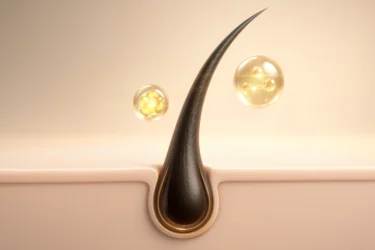
Fenugreek seeds are said to stimulate hair growth by nourishing the hair follicles and increasing blood circulation to the scalp9. The proteins present in fenugreek seeds are supposed to strengthen the hair shaft, reducing hair fall and promoting the growth of new, healthy strands.
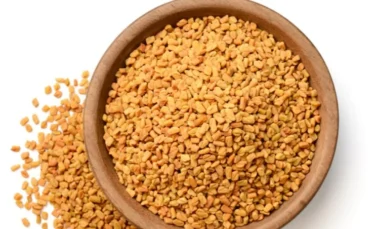
The proposed mechanism by which it may work is the fact that the various plant compounds in fenugreek may interact with a chemical in the body known as dihydrotestosterone (DHT). If DHT attaches itself to your hair follicles, the result, sooner or later, would be hair loss. Fenugreek may slow down the ability of DHT to attach to your hair follicles9.
A small study13 involving 53 people found that a 300 mg daily oral dose of fenugreek seed extract over six months led to improvements in hair volume and thickness for more than 80% of the participants compared to those given a placebo.

Fenugreek seeds contain hormone-regulating compounds that may help in reducing hair loss caused by hormonal imbalances. Additionally, the seeds have antimicrobial properties that may help protect the scalp from infections, reducing the risk of hair loss due to scalp conditions.
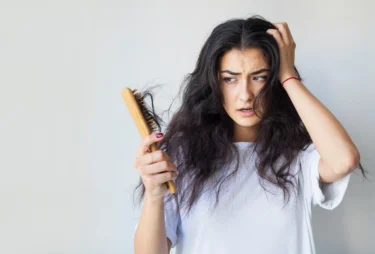
Fenugreek seeds possess conditioning properties that help in reducing dryness and frizz. Regular use of fenugreek seeds as a hair mask or rinse may make your hair soft, smooth, and manageable. They also provide hydration to the scalp, reducing flakiness and itching.

The antifungal and antibacterial properties of fenugreek seeds may be responsible for anti-dandruff effects4. Regular application of fenugreek seed paste or oil may help reduce scalp inflammation, itching, and flaking associated with dandruff5.

Fenugreek’s anti-inflammatory properties may help reduce scalp inflammation and alleviate itchy, red, or irritated skin1. This may aid in improving overall scalp health and promote healthy hair growth.
There are medical conditions also that may affect your hair and scalp, causing scalp issues and hair loss. If you are unsure, it is best to consult a dermatologist before initiating any home remedy.
For most people, fenugreek seeds are safe. However, in my opinion, one should avoid them before the 37th week of pregnancy as they may cause early labour. If you have a peanut or chickpea allergy, you are advised to stay away from fenugreek12.
Dr. Siddharth Gupta, B.A.M.S, M.D (Ayu)
Fenugreek can be incorporated into your hair care routine in multiple ways, which are described below.

You can use raw fenugreek seeds as a natural hair mask or hair oil. Simply grind the seeds, create a paste, and apply it to your hair and scalp. Leave the paste on for a few minutes before rinsing it off.

Fenugreek powder can be used as a hair mask or mixed with other ingredients, such as yogurt, honey, or oils, to create a nourishing paste. Apply the paste to your scalp and hair, focusing on the roots, and leave it on for about 30 minutes before rinsing thoroughly with lukewarm water.

You can make your own fenugreek oil by heating fenugreek seeds with a carrier oil, such as coconut or olive oil. Let the seeds infuse the oil for a few minutes, then strain the oil and store it in a clean container. Massage the fenugreek seed oil onto your scalp and hair, leave it on for an hour or overnight, and shampoo as usual.

Fenugreek supplements are available in the form of capsules, powders, and extracts, making it easy to incorporate this natural remedy into your daily routine. Consult with your healthcare provider before starting fenugreek supplementation, as it may interact with certain medications.

Fenugreek can be applied topically to your hair and scalp in the form of hair masks, hair rinses, shampoos, and conditioners11.
Fenugreek can be consumed in various forms to incorporate its benefits internally, which are described below.
While fenugreek is generally considered safe for most individuals, there are some possible side effects and risks associated with its use, which are as follows.
Overconsumption of fenugreek may cause the following:
Moderate your fenugreek intake and monitor your body’s reaction to ensure a safe experience.
Like any other herb, people allergic to legumes, peanuts, chickpeas, or related plants might be sensitive to fenugreek, causing inflammation, itchiness, or redness on the skin. If you notice any unusual reactions after consuming or applying fenugreek, discontinue its use and consult your healthcare provider.
Fenugreek might interfere with certain medications, including those used to control diabetes, blood clotting, thyroid disorders, and high cholesterol levels2. Consult with your doctor before taking fenugreek orally if you are on any medication.
When consuming fenugreek, it is crucial to adhere to the recommended dosages. A high dose of fenugreek may cause a sudden drop in blood sugar and may have hepatotoxic effects. Pregnant women should avoid fenugreek supplementation, as it may increase the risk of birth defects.
A holistic approach to hair growth addresses not only the application of topical remedies and supplements for hair health but also considers various factors that can influence hair growth.

Consume a balanced diet rich in hair-friendly nutrients, such as protein, iron, zinc, vitamins, and healthy fats. Ensure that you are getting enough essential amino acids, vitamins, and minerals through your diet to support optimal hair growth6. Focus on a variety of whole foods, such as green leafy vegetables, lean protein sources, dairy products, and healthy fats.

Stress is known to affect hair growth negatively. Try incorporating stress management techniques such as breathwork, meditation, yoga, or exercise into your daily routine to help reduce stress and support better hair health7.

Certain lifestyle choices, such as smoking, excessive alcohol consumption, and poor sleep hygiene, can adversely impact hair health. Make a conscious effort to adopt healthier habits and prioritize restorative sleep to support your hair growth journey.

Choose hair care products suited for your hair type and avoid harsh chemicals, sulfates, parabens, and silicones. Adopt a gentle haircare routine, including regular scalp massages to stimulate blood circulation and promote hair growth.

Genetic factors play a significant role in hair loss and hair growth patterns. If you suspect a hereditary pattern of hair loss, consult your healthcare provider to discuss suitable options.
Fenugreek seeds offer remarkable benefits in hair growth and hair health, supported by scientific research and traditional practices. Incorporating fenugreek seeds into your hair care routine may help reduce hair loss, stimulate hair growth, address dandruff, scalp inflammation, and reviving damaged hair.
While using fenugreek may be beneficial, it’s essential to consider possible side effects, allergies, and medication interactions. Utilizing a holistic approach that encompasses proper nutrition, stress management, lifestyle modifications, and appropriate hair care products is crucial for promoting healthy hair growth.
It is not necessary to use fenugreek on your hair every day. Applying it 2-3 times a week as part of a hair mask or oil massage may provide sufficient benefits. Daily use may risk increasing Pitta dosha levels on your scalp.
There is no specific recommended amount of fenugreek for hair growth, as it may vary based on individual experiences and conditions. However, some studies suggest that a daily oral dose of 300 mg of fenugreek seed extract may significantly improve hair growth and thickness. Always consult your doctor before deciding to consume fenugreek.
Typically, you can leave a fenugreek mask on your hair for about 30-45 minutes before rinsing it off with warm water. If you have severely dry hair and dandruff issues, you may leave the mask overnight and wash it off the next morning.
Apart from providing essential nutrients for hair growth, fenugreek water is said to help flush out toxins from your body, improving digestion and bowel movement. As a result, fenugreek contributes to maintaining the harmony of your Ayurvedic doshas in the body, which in turn, is said to promote voluminous hair growth and avoid dryness and dandruff issues5.
Studies suggest that significant improvements in hair growth can be observed after using fenugreek consistently for 3-4 months. However, the duration to achieve desired results may vary among individuals, depending on their unique hair needs and conditions. You may try fenugreek, after using it if you feel there isn’t much improvement then there may be some other reason for hair loss, and it is better to consult a dermatologist. Also, if you want to consume fenugreek then before doing so always discuss it with your doctor first.
Disclaimer: The information provided here is for educational/awareness purposes only and is not intended to be a substitute for medical treatment by a healthcare professional and should not be relied upon to diagnose or treat any medical condition. The reader should consult a registered medical practitioner to determine the appropriateness of the information and before consuming any medication. PharmEasy does not provide any guarantee or warranty (express or implied) regarding the accuracy, adequacy, completeness, legality, reliability or usefulness of the information; and disclaims any liability arising thereof.
Links and product recommendations in the information provided here are advertisements of third-party products available on the website. PharmEasy does not make any representation on the accuracy or suitability of such products/services. Advertisements do not influence the editorial decisions or content. The information in this blog is subject to change without notice. The authors and administrators reserve the right to modify, add, or remove content without notification. It is your responsibility to review this disclaimer regularly for any changes.
Skin tags, while not dangerous, can still annoy you and affect how you look. They often occur when your skin rubs against skin or clothing1. Even though they are harmless, many people want to remove them for aesthetic reasons or because they can get irritated.
This article will cover all you need to know about skin tags. You’ll learn what they are, why they appear, and the risk factors. We’ll discuss about home remedies and other products you may buy to remove skin tags, coupled with safety measures to follow. You’ll also learn when to reach out to a doctor and explore professional skin tag removal options. Lastly, we’ll go over how to care for your skin after the skin tags have been removed and steps to avoid future formation of skin tags.
Did you know?
Skin tags are harmless growths that usually don’t cause health issues, but can still bother you. Before starting any removal process, it’s key to understand what skin tags are and correctly identify them.
Skin tags, also called acrochordons, are small, soft lumps of skin that arise when skin rubs together. Usually, they are between 2 and 5 millimeters in size but can grow much larger. Skin tags can appear anywhere on the body but are often found near skin folds, like the neck, underarms, torso, eyelids, and inner thighs. They are often the same colour as your skin or darker, and usually don’t hurt unless irritated2.
We don’t know the exact cause of skin tags yet. Still, several known factors can increase your chances of getting these skin growths, which are listed below.
Before taking a swing at home remedies, be sure that it’s a skin tag and not something more serious. Ask a health professional if unsure. We’re about to list a few common home remedies for skin tags, how to use them, and the safety measures to bear in mind.
Safety Considerations: Keep in mind that removing skin tags yourself comes with risks like infection, bleeding, and scarring. If you feel discomfort in any way during or after applying home remedies, get in touch with a healthcare professional immediately. It’s vital to follow all guidelines and to only use clean, sanitized tools when trying these remedies.

This oil is known for its antiviral and antifungal traits and may prove to be a useful home remedy3.
How to apply?
Precautions
Don’t use pure tea tree oil and test it on a small bit of your skin before using it on a skin tag to check for allergies this is known as a patch test. Stay away from the eye area with this oil.

This vinegar is known for its acidic nature, which some say may help skin tags to shrink and drop off4.
How to use?
Risks and precautions
Be careful with apple cider vinegar as it can irritate the skin or cause burns. Be sure not to put it near the eyes and look out for signs of skin reactions while using it.

Some think garlic’s anti-inflammation might make skin tags look better5.
Application and precautions
Note, the strong smell of garlic might put some people off. And be careful if you have sensitive skin, as garlic can cause irritation.

Vitamin E is known for its antioxidant traits, which may fend off wrinkles and keep skin healthy6. Rubbing liquid vitamin E onto a skin tag might make it fall off in a few days.
Usage and benefits
Ensure that you do not have an allergy to vitamin E before using it on your skin. Also, know that using vitamin E near the eyes can be irritating.

Some say banana peels have antioxidant traits, which might help dry out skin tags7.
How to use?
Benefits
Using banana peels to remove skin tags costs little and is not invasive. Still, there isn’t much scientific proof that it works. So, you’ll need a lot of patience with this method, as it may take some time before you see any results.
Recently I came across a study that suggested skin tags can sometimes indicate a higher risk of heart and blood vessel problems. This is because people with skin tags often have other health issues like being overweight, high cholesterol, high blood pressure, insulin resistance, and increased inflammation in their bodies11.
Dr. Siddharth Gupta, B.A.M.S, M.D (Ayu)
For those not into home remedies, there are many over-the-counter (OTC) products to help you remove skin tags. Remember though, it’s best to talk to a health professional if you doubt using OTC products.

These creams can be found in loads of stores but may work better for some than others. It’s key to buy a cream that won’t irritate your skin. Be wary of creams holding salicylic acid and tea tree oil, as these might cause your skin to get red.

Such kits, or cryotherapy kits, use deep cold to kill unwanted skin tissue. These kits can be found in most drugstores and need to be used carefully so as not to hurt the surrounding skin. Always keep to the kit’s instructions and watch the skin area where you have applied the kit for bad reactions.

Skin tag removal bands, also known as ligation bands, work by cutting off the blood flow to the skin tag. This method takes time but might cause problems like infection, bleeding, and scarring. On the other hand, skin tag removal patches hold medicines that make the skin tag dry up and fall off. Results vary, and these patches could irritate the skin for some people.
Bands are wrapped around the base of the skin tag. This stops blood flow which kills the cells in the tag. The skin tag then dries up and falls off. Skin tag removal patches usually have medicines that slowly break down the surrounding tissue. This leads to the skin tag falling off.
Removal bands and patches may work, but DIY removal has risks. Be sure to keep everything clean and follow all instructions to lessen the risk of infection, bleeding, and scarring. Also, monitor the affected area for any unusual signs. If you have any bad reactions, talk to a health professional straight away.
To my knowledge, skin tags are way more common than you think. It has an estimated occurrence ranging from 50 to 60% among the general population12.
Dr. Rajeev Singh, BAMS
While home remedies and OTC products may help some people, there are times when it’s better to get help from a professional. Here are some such situations, described below.
Make sure to see a doctor if the following happens.
It’s crucial for a health professional to check and confirm that your skin growth is a harmless skin tag and not a more serious skin issue.
There are some situations when home remedies and OTC products are a no-go. Ask for professional help to remove a skin tag if:
It’s not widely known that skin tags, typically associated with humans, can also manifest on our furry friends, such as dogs. While common in older canines, these skin tags can present in various forms and are generally harmless. Yet, if you observe any alterations in their size, shape, or color, or if they cause discomfort to your pet, it’s advisable to seek evaluation from a veterinarian promptly.
Dr. Smita Barode, B.A.M.S, M.S.
If home remedies and OTC products don’t suit you, or if you want a quick fix, professional skin tag removal could be best. Health professionals offer different surgical methods to remove skin tags safely and swiftly.
After removing a skin tag professionally, you need to care for the area well to promote healing and stop infection.
If you understand why skin tags appear, you may try steps to lower their chances of forming.
Skin tags are harmless but sometimes vexing lumps that crop up at several body parts. If you decide that it’s needed, there are many home remedies, OTC products, and professional methods available to remove them. Don’t forget to be careful and follow safety measures when trying home remedies. For the best results and to keep risks low, consider asking a healthcare professional for skin tag removal. Aftercare is crucial to avoid infection and healing well. Knowing potential causes and risk factors for skin tags may help you take steps toward stopping them from forming.
Also Read: Healthy Skin Tips: Research-Backed Strategies for a Glowing Complexion
You may try several methods to remove skin tags at home, like using tea tree oil or apple cider vinegar. But these come with risks, including infection, bleeding, and scarring. It’s safer to consult a healthcare professional for the correct skin tag test and removal.
Keeping a healthy weight, managing diabetes, and sorting any hormonal imbalances may help lower the chance of skin tags forming. But, as things like genetics and infections can also lead to skin tags, completely avoiding them may not be possible.
Home removal methods come with risks like infection, bleeding, and scarring. Poor technique or unclean equipment increases these risks. Seeing a healthcare professional ensures proper removal and lowers these risks.
Once a skin tag is fully removed, it won’t grow back. But new skin tags may arise in the same spot or nearby.
Health insurance plans typically do not cover skin tag removal as it’s often looked at as a beauty-enhancing procedure. However, if a skin tag harms your physical or mental health, your insurance plan may provide coverage.
1. Pandey A, Sonthalia S. Skin Tags. [Updated 2023 Jul 31]. In: StatPearls [Internet]. Treasure Island (FL): StatPearls Publishing; 2025 Jan-. Available from: https://www.ncbi.nlm.nih.gov/books/NBK547724/
2. Healthdirect Australia. Skin tags (acrochordons) [Internet]. Melbourne: Healthdirect Australia; 2025 Mar [cited 2025 Nov 13]. Available from: https://www.healthdirect.gov.au/skin-tags
3. Carson CF, Hammer KA, Riley TV. Melaleuca alternifolia (Tea Tree) oil: a review of antimicrobial and other medicinal properties. Clin Microbiol Rev. 2006 Jan;19(1):50-62. doi: 10.1128/CMR.19.1.50-62.2006. PMID: 16418522; PMCID: PMC1360273. Available from: https://pmc.ncbi.nlm.nih.gov/articles/PMC1360273/
4. Luu LA, Flowers RH, Gao Y, Wu M, Gasperino S, Kellams AL, Preston DC, Zlotoff BJ, Wisniewski JA, Zeichner SL. Apple cider vinegar soaks do not alter the skin bacterial microbiome in atopic dermatitis. PLoS One. 2021 Jun 2;16(6):e0252272. doi: 10.1371/journal.pone.0252272. PMID: 34077434; PMCID: PMC8172074. Available from: https://pubmed.ncbi.nlm.nih.gov/34077434/
5. Pazyar N, Feily A. Garlic in dermatology. Dermatol Reports. 2011 Apr 28;3(1):e4. doi: 10.4081/dr.2011.e4. PMID: 25386259; PMCID: PMC4211483. Available from: https://pmc.ncbi.nlm.nih.gov/articles/PMC4211483/
6. Keen MA, Hassan I. Vitamin E in dermatology. Indian Dermatol Online J. 2016 Jul-Aug;7(4):311-5. doi: 10.4103/2229-5178.185494. PMID: 27559512; PMCID: PMC4976416. Available from: https://pmc.ncbi.nlm.nih.gov/articles/PMC4976416/
7. Hikal WM, Said-Al Ahl HAH, Bratovcic A, Tkachenko KG, Sharifi-Rad J, Kačániová M, Elhourri M, Atanassova M. Banana Peels: A Waste Treasure for Human Being. Evid Based Complement Alternat Med. 2022 May 13;2022:7616452. doi: 10.1155/2022/7616452. PMID: 35600962; PMCID: PMC9122687. Available from: https://pmc.ncbi.nlm.nih.gov/articles/PMC9122687/
8. Tribonias G, Papaefthymiou A, Zormpas P, Seewald S, Zachou M, Barbaro F, Kahaleh M, Andrisani G, Elkholy S, El-Sherbiny M, Komeda Y, Yarlagadda R, Tziatzios G, Essam K, Haggag H, Paspatis G, Mavrogenis G. Endoscopic Local Excision (ELE) with Knife-Assisted Resection (KAR) Techniques Followed by Adjuvant Radiotherapy and/or Chemotherapy for Invasive (T1bsm2,3/T2) Early Rectal Cancer: A Multicenter Retrospective Cohort. J Clin Med. 2024 Nov 18;13(22):6951. doi: 10.3390/jcm13226951. PMID: 39598095; PMCID: PMC11594537. Available from: https://pubmed.ncbi.nlm.nih.gov/39598095/
9. Dyck PKV, Hockaden N, Nelson EC, Koch AR, Hester KL, Pillai N, Coffing GC, Burns AR, Lafontant PJ. Cauterization as a Simple Method for Regeneration Studies in the Zebrafish Heart. J Cardiovasc Dev Dis. 2020 Oct 3;7(4):41. doi: 10.3390/jcdd7040041. PMID: 33022937; PMCID: PMC7711552. Available from: https://pubmed.ncbi.nlm.nih.gov/33022937/
10. Prohaska J, Jan AH. Cryotherapy in Dermatology. [Updated 2023 Sep 15]. In: StatPearls [Internet]. Treasure Island (FL): StatPearls Publishing; 2025 Jan-. Available from: https://www.ncbi.nlm.nih.gov/books/NBK482319/
11. Sari R, Akman A, Alpsoy E, Balci MK. The metabolic profile in patients with skin tags. Clin Exp Med. 2010;10:193‑7. doi:10.1007/s10238-009-0086-5. Available from: https://link.springer.com/article/10.1007/s10238-009-0086-5
12. Pandey A, Sonthalia S. Skin Tags. [Updated 2023 Jul 31]. In: StatPearls [Internet]. Treasure Island (FL): StatPearls Publishing; 2025 Jan-. Available from: https://www.ncbi.nlm.nih.gov/books/NBK547724/
Disclaimer: The information provided here is for educational/awareness purposes only and is not intended to be a substitute for medical treatment by a healthcare professional and should not be relied upon to diagnose or treat any medical condition. The reader should consult a registered medical practitioner to determine the appropriateness of the information and before consuming any medication. PharmEasy does not provide any guarantee or warranty (express or implied) regarding the accuracy, adequacy, completeness, legality, reliability or usefulness of the information; and disclaims any liability arising thereof.
Links and product recommendations in the information provided here are advertisements of third-party products available on the website. PharmEasy does not make any representation on the accuracy or suitability of such products/services. Advertisements do not influence the editorial decisions or content. The information in this blog is subject to change without notice. The authors and administrators reserve the right to modify, add, or remove content without notification. It is your responsibility to review this disclaimer regularly for any changes.
Feeling a tingle in your hands? It may be more than a minor annoyance and could signal an underlying health issue. That is why it is important to understand the possible causes and known when to see a doctor. In this article, we’ll explore why you experience tingling in the hands and discuss potential management options.
This article highlights the main reasons behind hand tingling, ranging from common causes like diabetes, vitamin deficiencies, and pinched nerves to less-known ones like vasculitis and Guillain-Barré syndrome. We will also discuss the role of autoimmune disorders and infections, along with possible management strategies to guide you.
What does tingling in your hands feel like? Most people describe it as a “pins-and-needles” sensation. It can accompany numb hands, aching pain, or weak muscles. Let’s understand what tingling really is and why it happens.
Tingling is a prickly or itching sensation. It may not always be painful, but it does cause discomfort. It is also important to understand that tingling in your hands and feet now and then can be normal, but if it keeps happening or is always there, it could point to a serious underlying health problem.
Hand tingling is usually perceived as
Tingling of the hands may be caused by many factors. It could be a temporary problem or may point to a bigger underlying problem. Let’s look closer at some likely causes of tingling in the hands.
Diabetic neuropathy is nerve damage caused by high blood sugar levels. It often affects the hands and feet and is characterised by tingling sensations in the extremities4. Therefore, managing diabetes and maintaining normal glucose levels is essential to reduce the risk of developing further complications.
Group B vitamins are key for supporting nerve health. If you’re deficient in these (especially vitamin B12), your peripheral nerves might be affected and cause hand tingling1.
When surrounding tissues put too much pressure on a nerve, it can become pinched, leading to tingling or numbness in the area that nerve serves1. Changing your body position or undergoing physiotherapy may relieve the symptoms.
Carpal tunnel syndrome is a common condition, where the median nerve in the wrist is compressed, causing tingling and numbness in the hands and fingers2. To help reduce carpal tunnel symptoms, wear wrist splints and adopt ergonomic practices to keep the wrist straight.
If kidney function is impaired, waste products can build up in the bloodstream and damage the nerves. This nerve damage can result in a tingling sensation in the hands5. Therefore, it is crucial to manage kidney diseases and maintain a healthy lifestyle.
Swelling and fluid retention during pregnancy can put pressure on certain nerves, sometimes causing tingling in the hands2. Simple measures such as changing hand positions, gentle stretching, and adequate rest may help ease discomfort.
Some drugs may damage the nerves, which can trigger a tingling sensation in the hands and feet. Consulting a doctor may help determine the most appropriate management plan.
Pain, numbness, or tingling in your thumb, index finger, middle finger, and part of your ring finger may be a sign of carpal tunnel syndrome. If it worsens at night or after a particular activity, it should not be ignored.
Dr. Ashish Bajaj, M.B.B.S., M.D. in Clinical Pharmacology and Toxicology
Some autoimmune and infectious diseases may also cause tingling in the hands. In autoimmune conditions, the body’s immune system mistakenly attacks its own cells (including the nerves, leading to a tingling sensation). In infections, the immune system attacks the invading germs, but the resulting inflammation may affect the nerves, causing a tingling sensation1.
Autoimmune disorders may lead to hand tingling if the immune system mistakenly attacks nerves or the tissues that support them. Identifying autoimmune disorders early and managing them well may help lower symptoms. Autoimmune disorders that may be associated with hand tingling include:
Rheumatoid arthritis is an autoimmune condition that triggers joint inflammation3. This may lead to hand tingling, especially in the wrists. To manage it, doctors may suggest pain-reducing medicines, anti-inflammatory medications, and physiotherapy.
Multiple sclerosis occurs when your immune system attacks the protective layer of the nerves, which is called myelin. This can cause nerve damage, bringing about tingling and numbness in the limbs, face, and other parts of the body. Detecting and managing this disease early may help to slow it down.
Lupus is an autoimmune disorder that can harm various body parts and cause nerve inflammation, leading to tingling sensation in the hands. Managing it involves taking medications and making lifestyle changes.
Celiac disease is an autoimmune disorder in which eating gluten damages the small intestine. It may cause hand tingling due to celiac neuropathy, sometimes even without digestive system symptoms. Following a strict gluten-free diet may help manage the condition.
Some individuals may develop a rare disorder called Guillian Barre syndrome after an infection like a stomach infection or the flu. The syndrome first starts as weakness and tingling in the hands and feet and then spreads, causing whole-body paralysis. In this condition, the immune system of the body starts attacking the nerves1.
If the tingling sensation in your hands does not go away in a few minutes or repeatedly appears over a few days, then it could be because of an additional condition or nerve damage. If you have been in an accident or think you have had an injury, seek medical help even if you don’t have any visible injuries.
Dr. M.G. Kartheeka, MBBS, MD(Pediatrics)
Infections can sometimes set off nerve inflammation, resulting in hand tingling. Thus, managing the infection correctly is key to possibly reducing related symptoms. Infections that may be associated with hand tingling include:
Ticks transmit Lyme disease, a bacterial infection. If not managed, it can affect the nervous system and cause hand tingling6. Timely treatment with antibiotics may help control the infection and possibly reduce the tingling sensation.
The varicella-zoster virus can reactivate and trigger shingles6, a painful rash caused by damaged nerve fibres. If it affects the nerves of the hands and arms, you may feel tingling and itchiness. Antiviral medications may help in reducing the rash’s duration and intensity.
Hepatitis B and C are viral infections that mainly affect the liver. If untreated, they can lead to inflammation, cirrhosis, or liver cancer and trigger peripheral neuropathy, resulting in occasional hand tingling. Identifying these conditions and managing them is essential to prevent their progression.
HIV weakens the immune system, increasing the chance of other infections and cancers. If left unchecked, it can worsen and severely damage the immune system6. The virus may also affect the nervous system, causing tingling and numbness. Managing and monitoring HIV in time is of paramount importance to help slow disease progression and help reduce complications like nerve-related tingling.
This bacterial infection affects the skin, nerves, and respiratory tract6. When it affects the nervous system, it can bring about tingling or numbness in the affected body parts, including the hands. Early diagnosis and treatment with appropriate antibiotics is important.
There may be other reasons for experiencing tingling in your hands, as follows:
Hypothyroidism occurs when the thyroid gland fails to make enough thyroid hormones. In severe cases, it may damage the nerves7, leading to tingling and numbness in the hands and feet. Its management usually includes thyroid hormone replacement therapy.
Some toxins and chemicals act as neurotoxins, harming the nervous system and causing tingling or other symptoms1. Avoiding heavy metals, industrial chemicals, and toxic substances may help reduce the chance of nerve damage.
Fibromyalgia brings about body-wide muscle pain, fatigue, and mood shifts. Some patients with fibromyalgia might feel tingling in their hands. Medications, exercise, stress reduction, and sleep hygiene may ease these symptoms.
Ganglion cysts are liquid-filled bumps that mostly arise around the joints. They can press against nearby nerves, causing tingling in the hand or fingers8. Treatment options include aspiration, immobilisation and, in some cases, surgery.
With age, changes in the cervical (neck region) spine can cause worn-out spinal discs, bone spurs, or arthritis. If these press on the spinal cord, they can lead to worsening neck pain and numbness or tingling in the arms and legs9. Possible management options may be physical therapy, drugs, or surgery.
Raynaud’s phenomenon affects blood flow to the hands and feet. Cold temperatures or stress can cause blood vessels to constrict, reducing blood flow, and leading to numbness or tingling in the fingers and toes. Warming the affected areas, avoiding triggers, and certain medications may help manage the symptoms.
Long-term alcohol use can damage nerves, leading to tingling in the hands and feet10. Cutting down on or quitting alcohol, improving the diet, and seeking medical support may help manage this condition.
Finding the root cause of hand tingling is key to proper management. Always consult a healthcare provider for diagnosis and management. They will consider your overall health, medical history, family history, lifestyle, and symptoms to identify possible causes.
Your healthcare provider may use different tools to find the exact cause of hand tingling, as follows:
Once the root cause is identified, your healthcare provider may advise the best way forward, which may include:
Managing stress, regular exercise, a healthy diet, and good sleep hygiene may help keep hand tingling away.
Depending on the cause, prescription drugs, over-the-counter remedies, or vitamin supplements may be advised by your doctor to help manage your symptoms.
Physical therapy, chiropractic care, massage therapy, acupuncture, or other alternative options may be able to offer relief for tingling hands1.
Important: Treatment must always be done as per your healthcare provider’s advice. Self-diagnosis and self-medication must be avoided at all costs.
If you have frequent occurrences of hand tingling, especially with other worrying symptoms, you should consult your doctor as soon as possible.
Watch out for symptoms like swelling in the limb or poor limb strength, numbness, dizziness, or breathing problems, along with hand tingling, as they can indicate serious conditions. In such a case, you need to consult your doctor immediately.
The earlier you find the cause of hand tingling, the better. Timely management may reduce symptoms and stop further issues.
Rarely, hand tingling or numbness might hint at a life-risk event, like a stroke or heart attack. If you experience symptoms like face drooping, slurring of speech, shortness of breath, cold sweats, or discomfort in the chest, neck, jaw, or stomach along with hand numbness11, call an ambulance at once.
Following healthy habits and taking appropriate steps to address the root cause may keep hand tingling at bay.
Adopting simple lifestyle changes can support overall health and may help reduce hand tingling. Some helpful practices include:
A diet with a lot of vitamins and minerals may keep nerves healthy. It may also help reduce vitamin deficiency that often triggers tingling.
Regular workouts and good body posture may help avoid pinched nerves. It may also boost blood flow in the body, reducing the chance of hand tingling.
Lowering your stress levels may reduce the chance of conditions that can trigger hand tingling.
Working with your healthcare provider to manage existing conditions (like diabetes and autoimmune disorders) may help reduce tingling.
Hand tingling may result from temporary issues or more serious underlying causes. Identifying the cause is key to finding the most suitable management options and may also help prevent further health complications. Adopting healthy lifestyle habits, addressing existing conditions, and seeking timely medical advice can support overall well-being and may help reduce tingling in the hands.
Worry about hand tingling when it persists, gets worse, or is accompanied by other concerning symptoms, such as swelling, poor limb strength, numbness, dizziness, or severe pain. You should see a healthcare professional for a proper check and management.
Tingling in the hands can be a symptom of carpal tunnel syndrome, which is common during pregnancy due to fluid retention. However, it’s best to consult a doctor to discuss all potential causes2.
Yes, tingling in the hands and feet can be a sign of dehydration. When the body lacks sufficient fluids, electrolyte imbalances can occur, affecting nerve function and causing tingling sensations in the extremities. Rehydration is crucial to alleviate such symptoms.
Yes, tingling in the hands can be a sign of anxiety. During periods of heightened anxiety or panic attacks, the body can experience symptoms like tingling or numbness in the extremities due to increased adrenaline and changes in circulation patterns.
Tingling in the hands in the morning can be due to sleeping positions that compress the nerves, such as sleeping on the arms or hands. The compression can temporarily reduce blood flow and cause tingling sensations.
Tingling in the hands itself is not usually painful; it’s often described as a pins-and-needles sensation or numbness. However, the underlying conditions that causing the tingling, such as nerve compression or neuropathy, can sometimes be associated with pain or discomfort in addition to the tingling sensation.
Vertigo itself typically does not cause tingling in the hands and feet. However, some conditions, such as multiple sclerosis (MS) or vestibular migraines, may cause both vertigo and tingling. It’s important to consult a healthcare provider to determine the underlying cause.
High cholesterol typically does not directly cause tingling in the hands. However, complications related to high cholesterol, such as atherosclerosis (narrowing of arteries due to plaque buildup), may lead to reduced blood flow to the extremities, potentially causing tingling sensations. Managing cholesterol levels through lifestyle changes and medications can help reduce the risk of such complications.
Disclaimer: The information provided here is for educational/awareness purposes only and is not intended to be a substitute for medical treatment by a healthcare professional and should not be relied upon to diagnose or treat any medical condition. The reader should consult a registered medical practitioner to determine the appropriateness of the information and before consuming any medication. PharmEasy does not provide any guarantee or warranty (express or implied) regarding the accuracy, adequacy, completeness, legality, reliability or usefulness of the information; and disclaims any liability arising thereof.
Links and product recommendations in the information provided here are advertisements of third-party products available on the website. PharmEasy does not make any representation on the accuracy or suitability of such products/services. Advertisements do not influence the editorial decisions or content. The information in this blog is subject to change without notice. The authors and administrators reserve the right to modify, add, or remove content without notification. It is your responsibility to review this disclaimer regularly for any changes.
Ever found yourself confused at the grocery store, not sure if you should go for brown or white eggs? No need to feel alone, most people are in the same boat. Some folks think that one kind of egg might be a better pick health-wise or flavour-wise over the other. This article aims to wipe away such confusion by breaking down the facts about brown and white eggs. We will delve into what affects the colour of an eggshell, compare the nutritional values of brown and white eggs, and talk about how they influence taste, cooking and cost. In the end, you will be able to make a wise choice when buying eggs and know what truly sets brown eggs apart from white ones.
Many people believe that the colour of an egg determines its health benefits or nutrients. But the colour of an egg, whether white, brown or even blue, is determined by the chicken breed and its genes. The primary pigment in brown eggshells is something called protoporphyrin IX, and blue eggshells get their colour primarily from the pigment biliverdin1,2. While factors like the chicken’s feed or environment might bring in shade variations, they don’t change the eggshell’s main colour.
Did you know?
Several myths about egg colour have been circulating for quite some time, and it is time to bring the truth to light:
After debunking these myths, let’s look at how brown and white eggs stack up nutritionally.
It is important to note that brown and white eggs have about the same nutritional value5. The only difference lies in the eggshell colour, which is determined by the chicken breed and genes.
Both brown and white eggs are rich in high-quality protein and healthy fats and have trace amounts of carbs with no significant differences in macronutrient profiles6. Regardless of the egg size, grade, and colour, they will provide all the vital nutrients your body needs.
Eggs, both brown and white, are loaded with essential vitamins and minerals, such as vitamins D, B12, A, and E, as well as iron, calcium, and phosphorus6. These nutrients support various functions like boosting immunity, improving brain function, and strengthening the bones6.
Cholesterol is crucial for our cells and helps provide vital hormones. Studies have shown that dietary cholesterol doesn’t affect blood cholesterol levels for most people6. Since both brown and white eggs have similar cholesterol levels7, whether you eat brown eggs or white, the chances of them hurting your heart’s health are low.
As seen earlier, there is no major nutritional difference between brown and white eggs. But does the colour of the eggshell matter when it comes to taste and cooking?
Whether an egg is tasty or not is not determined by its outer shell. It depends on factors like the hen’s diet, the environment it was raised in, and how fresh the egg is4. Therefore, brown, and white eggs do not have any inherent taste differences.
You can use white or brown eggs interchangeably in almost all recipes without noticing any changes in flavour, texture, or appearance. Please note that minor differences may be noticed during cooking based on egg freshness and size.
Baking with brown or white eggs gives the same results. Just make sure to use eggs of the same size as mentioned in the recipe, regardless of shell colour, and you should be fine.
Whether your eggs are scrambled, fried, or hard-boiled, you will not taste or feel any difference based on egg colour. You can switch between brown and white eggs when making these dishes without altering the final outcome.
From my observations, it appears that both white and brown eggs, regardless of their shell colour, may offer a consistent nutritional profile. Each egg, whether white or brown, may offer a substantial 6 grams of protein while containing only around 70 calories!
Dr. Siddharth Gupta, B.A.M.S, M.D (Ayu)
Studies suggest that chicken breeds, eggshell pigments, and a chicken’s living conditions and diet determine the egg colour. Let us see how these factors affect egg colour.
Different chicken breeds lay different coloured eggs. For instance, White Leghorn chickens lay white-shelled eggs, while chickens like Plymouth Rocks and Rhode Island Reds lay brown-shelled eggs8.
The chicken produces pigments that colour the eggshell. For instance, brown eggshells get their colour from protoporphyrin IX, while blue eggshells owe their colour to biliverdin2. Both pigments come from compounds known as porphyrins that form when heme (found in red blood cells) breaks down9.
The chicken’s diet, environment, and stress level can slightly alter the eggshell colour1. However, these factors cannot fundamentally change the colour of the eggshell.
Eggshells can have various other colours, like blue, green, and even pink2,5! Different chicken breeds, e.g., Araucana, Lushi, and Dongxiang, produce these uniquely coloured eggs2. The porphyrins, the same compounds that give colour to brown and blue eggshells, are responsible for these colour variations.
Based on my years of experience, I’ve come to believe that when it comes to nutritional value, both brown and white eggs might offer similar benefits. Notably, both types of eggs contain a significant amount of choline per 100g, potentially surpassing many other common food options. So, including brown or white eggs in your diet might be a simple and effective way to enhance your choline intake11.
Dr. Rajeev Singh, BAMS
Have you ever noticed that brown eggs are usually more expensive than white eggs at the grocery store? Let us dissect the reasons behind this price difference.
As we mentioned earlier, brown eggs usually cost more because the hens that lay them eat more because of their larger size. This increased cost of feed gets passed onto consumers through higher prices for brown eggs.
Additionally, consumer perception influences pricing. As brown eggs gain popularity, producers may raise their prices, taking advantage of the common belief that brown eggs are healthier or tastier than white ones, even though no scientific evidence supports these ideas. Even customers are ready to pay premium prices for brown-coloured eggs10.
Brown egg–laying hens might have slightly higher breeding, rearing, and feeding costs because of their larger size. Even so, these costs are not dramatically different and probably do not entirely explain the price disparity we see in supermarkets.
Brown eggs have become more popular recently; therefore, the demand for brown eggs has shot up, leading to potential price adjustments by producers. Increased consumer preference for brown eggs affects their pricing, despite no clear-cut differences in taste or nutritional value between white and brown eggs.
I may emphasize that if you have any heart-related condition or high cholesterol levels, it is important to be cautious about consuming brown or white eggs. In such cases, it may be advisable to limit your intake to three to four whole brown or white eggs per week. This precautionary approach might help manage the potential risk of adverse effects on your cardiovascular health12.
Dr. Smita Barode, B.A.M.S, M.S.
So, how do we decide which eggs to buy since brown and white eggs are equally nutritious and differ only in appearance?
When shopping for eggs, it is best to look beyond the colour. Think about other factors that truly affect the taste and nutritional value of the eggs, which include:
These factors can have a significant effect on the quality and taste of the eggs you eat. They are more relevant to your health than the colour of the eggshell.
Based on the multifactorial comparison between brown and white eggs, there is no significant difference between the two in nutrition, taste, or even cooking. The main thing that sets them apart is eggshell colour, determined by the breed and genetic makeup of the laying hen. Factors like the hen’s diet and living conditions play a much bigger role in the egg’s nutrition profile and taste.
To make the best choice when buying eggs, focus on aspects that really influence egg quality and taste, such as organic farming techniques, whether the hens are cage-free or free-range, and if the eggs are omega-3-enriched. This approach will ensure that you not only consider the eggshell colour but also the aspects that really matter.
There may be minor shell thickness variation within the same breed due to factors like chicken genes or age. However, the colour of the eggshell doesn’t determine shell thickness.
Usually, chickens with white earlobes lay white eggs, and those with red earlobes lay brown eggs. However, there are exceptions, and earlobe colour isn’t a foolproof way to predict what colour eggs a chicken will lay.
Brown and white eggs have similar environmental footprints. The production method (organic, cage-free, free-range, etc.), rather than the colour, influences the environmental impact of eggs.
A single chicken can’t lay both brown and white eggs. But, you can have a mixed flock of chickens that lays both brown and white eggs. The chicken breed and genetics determine the colour of the eggs they lay.
No, the colour of the eggshell doesn’t influence the yolk colour. The chicken’s diet plays a major role in determining the yolk colour. For instance, a diet loaded with carotenoids (found in leafy greens and some yellow and orange fruits and vegetables) can make the yolk deep orange.
Disclaimer: The information provided here is for educational/awareness purposes only and is not intended to be a substitute for medical treatment by a healthcare professional and should not be relied upon to diagnose or treat any medical condition. The reader should consult a registered medical practitioner to determine the appropriateness of the information before consuming any medication. PharmEasy does not provide any guarantee or warranty (express or implied) regarding the accuracy, adequacy, completeness, legality, reliability, or usefulness of the information; and disclaims any liability arising thereof.
Links and product recommendations in the information provided here are advertisements of third-party products available on the website. PharmEasy does not make any representation of the accuracy or suitability of such products/services. Advertisements do not influence the editorial decisions or content. The information in this blog is subject to change without notice. The authors and administrators reserve the right to modify, add, or remove content without notification. It is your responsibility to review this disclaimer regularly for any changes.
Next Page »« Previous Page